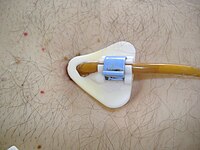
Photo from wikipedia
Traditionally, pain relief for abdominal surgery has centred on epidural analgesia, but transversus abdominis plane block is increasingly being used. Our aim was to compare the analgesic efficacy and the… Click to show full abstract
Traditionally, pain relief for abdominal surgery has centred on epidural analgesia, but transversus abdominis plane block is increasingly being used. Our aim was to compare the analgesic efficacy and the side‐effect profile of transversus abdominis plane block with epidural analgesia in a systematic review with meta‐analysis and trial sequential analysis. After a systematic search of the electronic databases, we identified 18 randomised controlled trials with 1220 patients. Confirmed by trial sequential analysis, our first co‐primary outcome, postoperative pain score at rest at 12 h, was decreased by a mean difference (95%CI) of 0.69 (0.12–1.27; p = 0.02) with epidural analgesia compared with transversus abdominis plane block, with the quality of evidence graded as low. No difference was found for the second co‐primary outcome, postoperative pain score at rest at 24 h, with the quality of evidence rated as very low. Relative to transversus abdominis plane block, epidural analgesia further reduced the need for intravenous morphine‐equivalent consumption during the 0–24 h interval by a mean difference (95%CI) of 5.91 mg (2.34–9.49; p = 0.001) at the expense of an increased incidence of hypotension at 72 h, with a risk ratio (95%CI) of 5.88 (2.08–16.67; p < 0.001). Our meta‐analysis was limited by detection and performance bias, significant statistical heterogeneity and publication bias. In view of the minimal clinically important difference in postoperative pain scores, epidural analgesia was interpreted to not be clinically different to transversus abdominis plane block after abdominal surgery. With transversus abdominis plane block, the increase in intravenous morphine‐equivalent consumption at 24 h should be balanced against the decreased risk of hypotension at 72 h. In choosing between epidural analgesia and transversus abdominis plane block, potential benefits should be balanced against the reported risk of harm, although the confidence in the evidence varied, underlining the uncertainty in our estimates.
Journal Title: Anaesthesia
Year Published: 2020
Link to full text (if available)
Share on Social Media: Sign Up to like & get
recommendations!